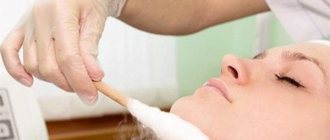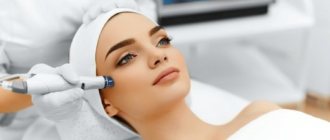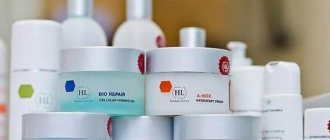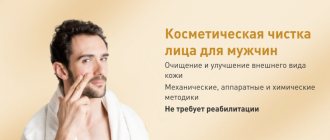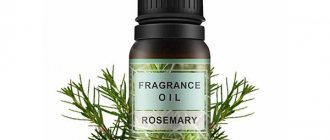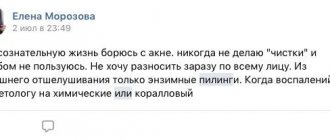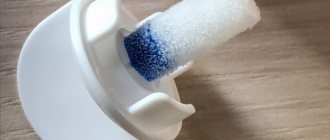The basis of healthy skin is the regular removal of dead skin cells. Thanks to cleansing, the processes of nutrition and breathing are improved, and lymphatic drainage is normalized. Facial care will prolong the youth of the skin, relieve acne, inflammation, and hypersensitivity. Atraumatic procedures are the most popular. They do not cause discomfort, and the recovery period proceeds unnoticed. Facial cleansing with nitrogen is indicated for solving various aesthetic problems. Thanks to therapy, it is possible to get rid of complex dermatological diseases and start rejuvenation processes.
The essence of cleaning
Under the influence of liquid nitrogen, the integument instantly cools, which leads to a sharp narrowing of the capillaries. After cooling, the particles of the substance freeze on the skin, helping to remove dead skin cells. The oxygen, vitamins and oxidants included in the mixture enrich and restore tissues. Then the vessels dilate, toxins, sebaceous secretions, and metabolic products are removed. As a result, microcirculation improves and the synthesis of elastin and collagen is activated.
The main difference from other types of cleansing is the ability to solve a whole range of aesthetic problems, including dermatological diseases. Care can be carried out for different skin types and has no age restrictions.
Note! It does not damage the integument, but the effect helps to activate collagen production and lymph outflow.
Indications for use
Exposure to low temperatures is often used by cosmetologists to solve various aesthetic problems. Despite the gentle effect, it is not recommended to use it in the summer. But active sun is not an absolute contraindication, so many experts practice cleansing in the spring and summer to improve the color and structure of the skin.
Indications:
- dermatological diseases, including acnitic, seborrheic keratosis;
- demodicosis;
- rosacea;
- acne, blackheads, sebaceous plugs;
- unhealthy color;
- inflammation, redness;
- loss of elasticity, firmness;
- signs of aging.
Cryotherapy and cryodestruction in the treatment of ENT diseases
The practice of recent decades has shown that for some diseases of the ENT organs, treatment with cryotherapy (from the Greek “krios”, i.e. cold) is a real and effective replacement for traditional surgical techniques. Cold treatment is based on the destruction of pathological tissues by ultra-low temperatures.
What is the difference between cryotherapy and cryodestruction? To begin with, let us clarify that both of these procedures are carried out using liquid nitrogen. Liquid nitrogen is a transparent liquid, colorless and odorless, with a boiling point of -195.8 C°. At normal atmospheric pressure it is non-flammable and does not burst.
So, the basis of the therapeutic effect of liquid nitrogen is its low temperature. Depending on the method of application, its effect on tissue varies. During cryodestruction, freezing can cause destruction (destruction) and death of tissue; this requires a longer, more than 30 seconds, exposure of the applicator over the removed element (tissue area). But with cryotherapy, short-term (10-15 seconds) freezing only causes a narrowing of blood vessels, followed by a response expansion of not only active, but also reserve capillaries, which significantly increases blood flow to the site of cryotherapy.
Efficiency of the procedure
The procedure has no age restrictions and can be used independently or as part of a program of treatment, restoration, and rejuvenation of the skin. Therapy helps improve the general condition of the integument and launch regeneration processes. As a result, it is possible to:
- refresh color;
- whiten pigmentation;
- prevent aging and the appearance of wrinkles;
- restore elasticity and firmness;
- tighten pores;
- get rid of acne, blackheads, comedones;
- level out bumpy terrain;
- cope with redness and inflammation.
The effect lasts for several months. Comprehensive facial care, adherence to the basics of a healthy lifestyle, and proper sleep will help preserve the results.
What devices and products are used for cleaning
The classic option is to treat tissues with swabs soaked in liquid nitrogen. Cosmetology parlors offer multifunctional cryotherapy machines.
There are also portable devices: Frotox is used to rejuvenate, give freshness, and reduce the number of wrinkles. The use of this device requires the use of anesthesia.
Attention! The choice of technique depends on the objectives of the procedure, as well as the qualifications of the doctor. Innovative technologies help to avoid complications when exposed to low temperatures.
Cryotherapy in a beauty salon: indications and contraindications
Cryotherapy will benefit all those who do not have compelling contraindications to this procedure, and will provide an excellent general strengthening and healing effect.
Cryotherapy in beauty salons and medical institutions is used for the following indications:
- obesity;
- cellulite;
- skin pathologies resistant to other treatment methods;
- gynecological and nervous diseases, ENT diseases;
- recovery in the postoperative period;
- treatment of injuries;
- combating chronic fatigue, depression, nervous exhaustion and sleep disturbances;
- age-related changes in the skin.
In beauty salons and dermatological centers, liquefied nitrogen is used to remove warts, moles, acne, scars, papillomas, and fight alopecia and seborrhea.
And this is not a complete list of indications for cryotherapy. It can be prescribed by the attending physician, who carefully monitors the course of the disease and the results of the procedures performed.
Main contraindications to cryotherapy:
- allergy to low temperatures;
- infectious diseases at any stage of their course;
- heart attack and ischemia of the heart muscle;
- stroke;
- hypertonic disease;
- pregnancy and breastfeeding;
- patient age under 16 and after 60 years.
Read material on the topic: Microcurrent facial therapy
Is preparation necessary and how to do it?
Cryotherapy does not require long preparation. It is important not to carry out procedures that injure the skin the day before. You should also not sunbathe to avoid causing hyperpigmentation. It is not recommended to use exfoliants, including superficial ones, before 12 hours.
On the appointed day you should not use decorative cosmetics. You should avoid drinking alcoholic beverages, salty, spicy, and sweet foods that increase the secretion of the sebaceous glands.
When taking medications, you should consult your doctor. Compliance with these conditions is enough to prevent undesirable consequences.
Is it possible to clean at home?
Liquid nitrogen is used exclusively in aesthetic medicine salons and clinics. But the effects of ice for skin care can also be used at home. To do this, follow these steps:
- Remove makeup using micellar water, rinse off the product, and blot with a cosmetic napkin.
- To enhance the effect of the procedure, you can steam the skin using a herbal compress.
- Apply an alginate, moisturizing, cleansing or nourishing mask. It is important that its composition does not contain fruit acids or clay; it is better to stick to products with hyaluronic acid and aloe. After 20 minutes, rinse with warm water.
- Put a fabric mask on your face, this will help avoid contact with ice and prevent unwanted consequences. Prepare 2 ice cubes in advance, preferably based on herbs, oils, essential oils and other active ingredients. Passing along the face parallel along the massage lines, without stopping at 1 point for more than 3 seconds, there is a high risk of tissue frostbite. The whole process takes no more than 3 minutes.
- Afterwards, apply a nourishing cream selected according to your skin type. You can first dip the tube in warm water, this will speed up the skin restoration process.
To prepare ice cubes for oily, problematic dermis, decoctions of chamomile, nettle, and sage are used, which have anti-inflammatory and antiseptic properties. To improve color and get rid of wrinkles, recipes include aloe juice, lemon, milk, almond oil, jojoba oil, apricot kernels, jasmine and sandalwood ether.
How does the procedure work?
The result of the cleaning depends on the experience of the cosmetologist. You can only trust a qualified specialist with a medical education.
It is important to study patient reviews and the effectiveness of the procedure to solve individual aesthetic problems. Many people note unusual, but not painful sensations; thanks to modern technologies, frostbite of tissues can be avoided.
After the procedure, it is not recommended to go outside for an hour, the protective barrier is reduced, and the tissues are susceptible to aggressive environmental factors. The procedure lasts about an hour, the main stage takes from 5 to 20 minutes. To achieve the desired effect, it is necessary to complete a course of 4–10 sessions, repeated every 2–3 days.
Stages of implementation:
- The patient lies down on the couch, the hair is hidden under a cap, and the body is covered to prevent nitrogen from entering.
- A dermatologist performs makeup removal using professional products.
- The specialist immerses a cotton swab in liquid nitrogen, the temperature of which is -196º. Treats the skin along massage lines in target areas. If the distribution is carried out too quickly, the substance evaporates and does not have the desired effect. With delayed processing there is a risk of tissue frostbite.
- At the last stage, the cosmetologist applies a restorative mask or moisturizer according to your skin type.
GUIDE TO CRYOSURGERY for general practitioners
What principles should cryosurgeons follow? What benign formations are subject to cryosurgery? What are the main side effects of cryosurgery procedures? What is the best way to organize a cryosurgery department in general practice?
It is well known that cryosurgery is easily adaptable to the capabilities of general practice, and the number of general practitioners offering cryosurgery procedures to their patients continues to grow. This trend may have been initially supported by additional payments to general practitioners for performing minimal surgical procedures, but today the effectiveness of dermatological cryosurgery in primary care and the availability of liquid nitrogen play a major role.
The doctor must have a clear understanding of the basic principles of cryosurgery. Inadequate treatment of even benign skin lesions often leads to complications, and an unjustified choice of treatment for malignant tumors can have very serious consequences.
Table 1. Surface tissue temperatures achieved using various cryogens
| Cryogen | Temperature (0C) |
| Dry ice | –79 |
| Nitric oxide | –75 |
| A liquid nitrogen | –20 (cotton-wool swab) –180 (spray) –196 (probe) |
Cryogen and operator.
A number of cooling agents have been used in clinical practice in the past. In table 1 shows the types of modern cryogens along with the corresponding decrease in surface temperature during their action.
For the treatment of benign superficial skin formations, a temperature of -200C is sufficient; malignant neoplasms require more severe regimes - up to -500C.
Liquid nitrogen, whose boiling point is –1960C, has the highest “deadly” subzero temperature for tissue destruction. Dry ice and nitric oxide provide adequate subzero temperatures for benign growths or superficial areas of sun-damaged skin such as solar keratoses, but are not as good as liquid nitrogen for destroying malignant skin growths.
| Figure 1. Application of liquid nitrogen using a cotton-wool swab. Freezing extends to an area of normal skin within a radius of about 1 mm |
Due to its availability, liquid nitrogen is often used in cutaneous cryosurgery. There are different freezing regimes recommended for different skin lesions.
Cryosurgery using dry ice and nitric oxide requires a longer exposure time than with liquid nitrogen, which should be kept in mind by clinicians transitioning from dry ice and nitric oxide to liquid nitrogen; to avoid side effects and complications.
It is also important that the operator is “experienced” in the treatment of benign tumors before moving on to the treatment of precancerous and cancerous tumors.
If there is no certainty about the origin of the tumor or a preliminary biopsy has not been performed, the cryosurgical method cannot be used.
The supply of liquid nitrogen can be arranged from several sources. Most suppliers of equipment for cryosurgery include in the contract the supply of flasks with liquid nitrogen of various volumes to the customer.
The pharmacy department of the local main hospital is usually happy to provide liquid nitrogen. In this situation, it is best to organize a group of patients in a permanent department, so that liquid nitrogen is delivered, say, once a month in a special transport container with a protective container.
The author has his own 50-liter Devar flask, which is replenished by the supplier every six weeks.
Cryofreezing.
Regardless of the equipment and method used, a white ice field forms on the surface of the skin during cryofreezing. Subsequently, deeper tissues are involved in the freezing process (Fig. 2).
| Figure 2. Open 30 second spray of freezing spots. Note the shape of the ice field, the attainment of lethal temperatures at a depth of 3 mm, and the lethal spread of freezing approximately equal to its depth* |
Histologically, cryofreezing causes ischemia and necrosis through direct cell injury, thrombosis, and microvascular failure. The faster the cooling, the lower the temperature achieved, and the slower the thawing, the more cells die.
The extent of tissue damage is related in part to the duration of freezing, but other factors are also important. Different cells, tissues and organisms have different intrinsic sensitivity to cold (Table 2). Melanocytes and basal cells die easily, while fibroblasts, collagen, nerve tissue and blood vessels are relatively immune to cold injury.
This fact constitutes one of the main cosmetic advantages of cryosurgery: negligible effect on connective tissue and relatively little damage to blood vessels and nerves under normal therapeutic regimens.
Vascularization of the underlying tissue also influences the rate or extent of cold injury. I also note that bacteria quickly die from freezing, but viruses do not.
Equipment and method.
The simplest way to deliver liquid nitrogen to the treatment site is to apply nitrogen using a cotton-wool swab, which is dipped into an open flask with nitrogen and pressed against the formation being treated until a white ice border appears around the swab (Fig. 1).
Table 2. Relative sensitivity to cold damage
| Cell/tissue/organism | Sensitivity |
| Melanocytes Basal cells Keratinocytes Bacteria Connective tissue Connective tissue membranes of nerve cells Endothelium of blood vessels Viruses | Sensitive to cold (easily killed) Insensitive to cold |
For larger lesions, repeated dipping and pressing of the swab may be necessary. In this case, to prevent cross-contamination between patients, it is necessary to stock up on small individual metal containers filled from a common flask.
Liquid nitrogen applied in this way makes it possible to achieve a temperature of the cooled surface not exceeding –200C. The technique is suitable for the treatment of benign superficial skin formations. These include superficial viral warts (the insulating properties of keratin in thick formations preclude cryosurgery), thin seborrheic warts, or very thin areas of solar keratosis (Figure 3). If there is the slightest doubt about the diagnosis, solar keratosis is subjected to a curettage biopsy.
| Figure 3. Solar keratosis, early stage. Very mild peeling |
The most effective method of using liquid nitrogen involves applying it to the formation using a spray. Today, cryosurgeons have several hand-held cryosurgical units at their disposal.
Cryoguns such as the CRY-AC (Figure 4) come with a 300- or 500-milliliter general liquid nitrogen flask. Its trigger effect allows you to precisely control the process and minimize the size of the resulting ice field. The set includes a variety of spray tips and probes, as well as angled and sliding extenders, allowing for more flexible application at different angles.
| Figure 4. Closed Supply System—300 and 500 mL Handheld Cryosurgery Systems with Various Spray Tips, Cryoprobes, and Curved Sprayers |
The freezing spot spray technique involves placing the tip of the liquid nitrogen spray at a height of about 1 cm above the center of the formation or surface being treated (see Fig. 5). With the start of processing, a circular “ice field” is formed.
If ice forms in the desired area, continue processing to maintain the size of the field for a time appropriate to the nature of the formation being treated (from 5 to 30 seconds). The time of freezing should be noted in the medical history, for example, a single 20-second exposure to the spray can be abbreviated as follows: Liq. N2 20s. one FTC (freeze-thaw cycle).
| Figure 5. Cryosurgical debridement of multiple warts on the hands using the freezing spot technique. |
When treating benign lesions larger than 2 cm in diameter or irregular in shape, the freezing spot can be modified by applying a “pattern” or spiral to ensure sufficient freezing of the entire lesion.
I don't use the cryoprobe often, but there are times when it works best:
- formations that require particularly precise and careful treatment, such as small seborrheic warts near the eye or on the eyelid;
- labial mucoid cysts, usually located on the mucous lining of the lips;
- some types of warts (see below).
When treating small or irregularly shaped lesions (especially malignant lesions such as cutaneous carcinoids that require a full freeze-thaw cycle) and surrounding areas or structures that require protective measures (such as the eyes), I prefer to use the guide as a protective field.
First, the edge of the lesion is outlined with a marker, covering at least 3 mm of healthy skin. A piece of guide with a hole of suitable size and shape is applied so that it surrounds the treated area. When treated with liquid nitrogen, the guide freezes to the outlined margins, protecting the normal surrounding tissue from cold damage.
| Figure 6. Precise direction of the liquid nitrogen stream using an appropriately sized ear funnel. This prevents unnecessary cryodamage to surrounding tissues and the nail bed. |
Thick, raised warts are relatively resistant to cryotherapy. The best results are achieved by first cutting off most of the keratin and then applying liquid nitrogen through an ear specula with an opening slightly larger than the size of the wart until an icy spot forms (Figure 6). The method allows you to achieve a good depth of limited freezing without cold damage to surrounding tissues.
All cryooperators should adhere to the following rules:
- be sure of the diagnosis, in doubtful cases, do a biopsy before freezing;
- do not treat children under 6 years of age;
- Explain the detailed procedure to the patient and provide him with an information booklet;
- treat deep or malignant tumors under local anesthesia;
- note freezing times, cycles and techniques - this allows you to establish a connection between freezing time, technique and result, and will help other doctors observing the patient to choose further methods of treatment.
Diagnostics.
It is useful to always keep the following in mind.
The patient must first be examined by a general practitioner who makes the diagnosis. If there is the slightest doubt about the correctness of the diagnosis, the cryosurgical method is not used. All malignant or suspicious lesions are biopsied prior to the cryosurgery procedure.
The medical record must include an explanatory histopathological report. And one last thing. If you have doubts about the correctness of the patient’s treatment method, honestly tell him about them and refer him to the appropriate specialist.
- Benign formations subject to cryosurgery
Cryosurgery is a fast and effective method for treating common benign tumors. If necessary, side effects and complications can be minimized by leaving the benign tumor untreated. Then, taking into account the reaction to the first procedure, a decision is made regarding further treatment.
Warts.
Most warts can be treated at home using astringents. If the patient agrees to cryosurgical treatment, some common and flat warts can be easily removed with liquid nitrogen using a cotton wool swab or spot freezing spray.
The first time, liquid nitrogen is applied once and for no more than 5 seconds, since some patients have increased sensitivity to it (Fig. 7). Subsequent treatment is determined by the response to the first exposure.
| Figure 7. Hemorrhagic blister occurring six hours after simple cryosurgical treatment of a common wart visible at the tip of the blister. |
The best results are achieved with repeated treatments at intervals of three to four weeks. When treating periungual warts, shorter repeated freezing sessions should be used to avoid causing severe pain to the patient and to avoid excessive damage to the nail matrix.
Warts around finger joints, nerves and tendons also need to be treated very carefully. For finger-shaped warts, especially on the face, I prefer to scrape them out under local anesthesia using a small ophthalmic curette and then lightly work the base with a fine heat cautery.
Viruses are relatively immune to liquid nitrogen (Table 2), and it is the destruction of the wart tissue that leads to the desired result. However, liquid nitrogen appears to stimulate an immune response to any existing warts, increasing treatment effectiveness and resistance to infection. Keratin does not pass liquid nitrogen well, so large warts must first be cut off with a scalpel. Thick, raised, circumscribed warts are better treated with the help of an ear funnel.
It is necessary to weigh the pros and cons before prescribing cryosurgical treatment for plantar warts. I initially treat most mosaic plantar warts with repeated 5% formaldehyde soaks and trimming of the rough tissue. This procedure is painless, and with good understanding with the patient and clear instructions, it usually gives a good result. Thick localized warts can also be treated with liquid nitrogen, after first cutting off the surface layer of keratin and using a probe slightly smaller in diameter than the formation itself. The use of special jelly ensures good contact with the probe throughout the entire freezing cycle. Freezing must continue long enough to form an ice rim around the probe. This method provides good, local, deep freezing with minimal damage to surrounding tissue, which reduces the likelihood of postoperative complications.
Seborrheic warts (keratoses).
Seborrheic warts multiply with age and normally do not require treatment. Indications for treatment include persistent irritation, disfiguring appearance (especially on the face), or disturbing pigmentation changes and occasional bleeding.
Such formations are easily removed with a relatively short-term single cryospray (4-8 seconds), and the spray should not extend beyond the formation by more than 1-2 mm. However, for thicker keratotic lesions or at the slightest suspicion of malignancy, especially highly pigmented lesions, curettage biopsy and thermocautery under local anesthesia are necessary (Fig. 8).
| Figure 8. Seborrheic warts come in different colors. If there is the slightest doubt about the diagnosis, a curettage biopsy should be performed. |
Purulent granulomas.
Post-traumatic or wound granulomas respond well to cryosurgical treatment. A 20-30 second freeze may be required here. If there is any doubt about the diagnosis, a biopsy is performed before or immediately during freezing.
I believe the proper treatment for a true ingrown toenail is to remove it. Cryotherapy helps reduce inflammatory granulations before the decisive stage of surgery.
Labial mucoid cysts.
To remove these benign formations, a single 10-20 second freezing with a cryoprobe of a suitable size is sufficient. If contact with the underlying mucosa occurs at the beginning of freezing, it is sufficient to slightly change the direction of application to reduce the risk of unnecessary cold damage to deep tissues.
Soft warts, body nevi and vascular formations.
The simplest way to treat soft warts and pedunculated papillomas is to cut them off and lightly treat them with a thermal cautery or simply cauterize them under local anesthesia or without it, depending on the patient’s wishes and the size of the formation.
Benign, elevated “body” nevi with many years of experience can be treated with cryosurgical treatment using a spray or probe. However, excellent cosmetic results with minimal complications are achieved by simply cutting off the lesion with a scalpel just above the surface of the skin and gently cauterizing it under local anesthesia. This allows for histological examination if there is the slightest doubt about the benignity of the nevus.
On the contrary, “spider” nevi respond better to “cold” cauterization using a special hot needle, which is included in the equipment of most electrocautery departments. The technique allows for coagulation of the main feeding subcutaneous vessels, which leads to involution and emptying of small tributaries without subsequent changes in pigmentation, which can develop when a cryoprobe is exposed to the entire nevus.
Hemangiomas are effectively treated by cryosurgery using a cryoprobe or auriscope. If the origin of the hemangioma is in doubt, a biopsy is performed.
With the right patient selection, equipment and skills, cryosurgery using liquid nitrogen represents a promising option for the treatment of some precancerous skin lesions, including Bowen's disease, and skin cancers such as basal cell carcinoma.
However, the purpose of this article is to discuss the safe use of cryosurgery in the treatment of benign skin lesions. Physicians wishing to improve their skills in cryosurgery should first consult more specialized literature (see list below for further reading) and gain practical experience under the supervision of a cryosurgeon.
- Side effects, complications and limitations of cryosurgery
During the freezing and thawing phase, patients always experience pain, and they should be warned about this before the cryoprocedure (see section “Tip List A: Wart Cryosurgery”). When treating extensive lesions and malignancies using more aggressive freezing regimens, local anesthesia is required.
In sensitive patients, blistering may occur even with short-term freezing using cotton wool swabs. Therefore, you should not delay the first procedure when treating benign formations, and you need to note the time to use it in subsequent procedures as a starting point.
The bladder may be filled with bloody contents (Fig. 7). Such a bubble looks scary, but it is easy to treat: it is opened with a sterile needle and a dry bandage is applied. Recovery occurs within one to two weeks.
After a cryosurgery procedure, it is not uncommon to develop edema or tissue swelling, especially in loose tissue of the eyelids and lips and when using the harsh freezing regimens required to treat malignancies. It is important to warn the patient about the possibility of developing edema (see section “Tip List B: after a cryosurgical procedure”). To alleviate the condition, an ointment containing steroids is used.
Changes in pigmentation after a cryosurgical procedure vary in severity. Often, even after treatment of benign neoplasms, post-inflammatory hyperpigmentation develops. It usually disappears gradually. Long-term cryogenic regimes can lead to subsequent hypopigmentation.
In cases of pigmented or tanned skin, it is worth considering alternative treatment methods to cryosurgery.
Hypertrophic scars rarely form during cryotherapy at therapeutic doses. The initially forming scab or subsequent keloid scar is usually characteristic of long-term cryogenic regimes. When using less than short-term regimens, hair follicles often die, so it is better not to use this method for treating the scalp or beard area. Damage to cartilage is caused only by the most severe freezing regimes.
- Organization of the cryosurgery department
To organize a service at a high professional level, you need to consider the following.
- Adequate training for doctors and nurses
- Acceptable source of liquid nitrogen
- Correct installation of cryosurgical equipment, local anesthetics, dressings, etc.
- If a biopsy is required, biopsy kits, local anesthetics, sutures, dressings and a histopathology kit are required
- The doctor and nurse must have time to work in the clinic.
Cryosurgery training
Cryosurgery is a fairly simple and effective technique that is increasingly used in pediatrics and nursing services, as well as by general practitioners.
Appropriate training must be completed so that the operator reaches a high level of competence before performing cryosurgery.
Training is carried out in different ways
- Many postgraduate training centers offer basic surgical courses for general practitioners. These typically include cryosurgery sessions under the supervision of a dermatologist or general practitioner with relevant experience and are often supported by cryosurgery equipment suppliers. General practitioners who can work in departments of medical centers or even lead nursing departments are also invited to these courses.
- Most consultant dermatologists welcome the desire of general practitioners to use cryosurgery to treat warts and benign growths and support their training in the future if the opportunity arises
- General practitioners trained in cryosurgical techniques may want to train nurses to treat warts. Any growth should initially be examined and assessed by a general practitioner. If a department is organized under the leadership of a nurse, it is important that she has sufficient experience and competence
List of tips A: cryosurgery of warts
- Your wart(s) have been treated with liquid nitrogen. Freezing destroyed the wart tissue. A feeling of stabbing pain appeared during treatment and may persist for some time, but, as a rule, the pain goes away after a few minutes. If the pain returns later, aspirin or paracetamol will give you relief.
- A blister may form over the treated area within one to two days. This is normal, cover it with adhesive tape. If you have any cause for concern, tell your GP
- After four weeks, you should visit the wart treatment department again to ensure that the treatment was adequate.
List of tips B: after a cryosurgery procedure
- After treatment with liquid nitrogen, the treated area will swell greatly and become wet. These phenomena can be significantly reduced if gauze with an ointment containing an antibiotic and a steroid drug is applied to the surgical area. The gauze is held in place with adhesive tape. The doctor will make the appropriate appointments
- After 10–14 days, a hard, dry, black, tight-fitting crust will form at the site of exposure. You will have to wait a week, or maybe a month, before it falls off and in its place there will be a pink scar that will definitely turn pale
- After the procedure there should not be much pain, but if necessary, you can take paracetamol. Rarely, severe pain or swelling indicates infection. In this case, the doctor will prescribe you a course of antibiotics. The nurse will show you how to change the bandage and clean the wound
- For any problem related to cryosurgery, please seek advice from the medical center
Care instructions after cleaning
Cryotherapy is a safe, atraumatic type of cleansing. Recovery is quick; during the first 24 hours, slight swelling and redness are possible. To consolidate the aesthetic effect, you should follow the recommendations of a specialist:
- for cleansing, use soft foams and gels without aggressive components;
- treatment of problematic oily skin continues at home, the cosmetologist selects the optimal care program, including cleansing, toning, moisturizing;
- after the procedure, scrubs, gommages, nourishing and moisturizing masks will help speed up skin restoration; it is advisable to choose products from a professional or therapeutic line;
- To prevent pigmentation and protect the skin from exposure to ultraviolet radiation, it is necessary to use a cream with a high SPF factor.
Important! During the recovery period after the procedure, you should not visit the sauna, solarium, swimming pool, or gym; there is a high risk of tissue infection.
Cryotherapy for face for acne
Cryotherapy has been found to be a very effective, reliable and relatively inexpensive way to remove most of the superficial skin lesions associated with acne. When used as an acne treatment, the area of skin is lightly frozen, so when the top layer of skin is frozen with liquid nitrogen, whiteheads and any other acne that is present is also removed. Cryotherapy treatment can also be used to help acne heal faster, which has the end effect of reducing any acne scarring.
Cryotherapy for acne treatment is usually done once a week. Side effects of this treatment may include burning and redness of the skin, and there may also be some pain for some period after treatment. The painful effects of liquid nitrogen treatment can be reduced by applying a steroid to the treated area immediately after treatment. In very rare cases, a patient with extremely sensitive skin may experience swelling and bloating after a cryotherapy session.
Cryotherapy is also sometimes called cryomassage or simply liquid nitrogen acne treatment, and it is essentially the same form of surgery with the same steps that an esthetician performs during the first procedure. This acne treatment has been available since the 1960s and has proven success. effectiveness as one of the best acne treatment options, but it is not as well known or widely advertised as acne treatments.
Precautionary measures
Despite the effectiveness and safety of cryotherapy, there are a number of contraindications for the procedure:
- pregnancy;
- tuberculosis;
- pathologies of the cardiovascular system;
- epilepsy;
- individual sensitivity to the effects of cold;
- viral infections;
- increased body temperature;
- rosacea;
- dark skin;
- violation of the integrity of the integument, wounds, burns.
It is important to pay special attention to choosing a specialist. The occurrence of side effects is due to insufficient qualifications of the cosmetologist. By following the procedure protocol and testing for cold intolerance, the risks of developing undesirable consequences are eliminated.
With insufficient experience, tissue frostbite may occur, accompanied by subsequent peeling and changes in pigmentation of the integument. For mild redness and swelling, treatment with topical steroids is performed to restore the skin. If carried out carelessly, drops of nitrogen may fall on the mucous membrane of the eyes, periorbital, and perioral areas. There is a high risk of tissue frostbite; the condition requires long-term rehabilitation.
Contraindications
- Cryomassage has the following contraindications:
- malignant tumors;
- rosacea;
- pregnancy;
- increased body temperature;
- herpetic infection;
- skin damage;
- any infectious diseases and inflammatory processes in the acute stage;
- presence of cold allergies.
Advantages and disadvantages
Cryotherapy is a popular procedure for facial and body care. But among the many advantages, there are also disadvantages that patients should know about in advance.
Pros:
- the procedure relieves inflammation and accelerates tissue regeneration processes;
- prescribed for the treatment of acne, blackheads, comedones;
- helps solve a whole range of cosmetological and dermatological problems;
- effective as an independent therapy, can also be supplemented with mechanical cleaning;
- has no age restrictions;
- affordable price;
- a cosmetic session can be carried out throughout the year;
- the risks of developing side effects are reduced.
Minuses:
- for a pronounced effect you need to undergo a course of procedures;
- carrying out is accompanied by uncomfortable sensations;
- there is a rehabilitation period, so it is better to perform the procedure on a day off;
- It is not carried out at home; it is recommended to contact a cosmetologist only.
Cryomassage frequency
To achieve the best effect, it is recommended to attend about 10-15 cryomassage sessions, which are carried out every two to three days. The fewer problems you have with your skin, wrinkles, acne and other imperfections, the fewer procedures you will have to apply. The best time of year for cryomassage is warm spring and early autumn - when there is no severe frost and precipitation outside the window, but there is also no scorching sun, heat, or strong exposure to ultraviolet rays.
Contraindications to the procedure
In what cases should you refrain from cryotherapy (temporarily or permanently)?
- presence of wounds, scratches, ulcers on the skin
- exacerbation of chronic, viral and autoimmune diseases
- pregnancy, breastfeeding period
However, it is worth knowing that these moments are quite individual. A competent cosmetologist will first examine you, determine the condition of your skin and draw conclusions about whether you should resort to cryomassage at this stage of your life.
Opinion of cosmetologists
On forums, experts discuss the specifics of using nitrogen in skincare procedures.
The cosmetologist does not recommend using the Jet Peel nitrogen procedure if you are allergic to peelings.
The specialist advises methods for removing grasses in the area of the nasolacrimal groove, including recommending the use of nitrogen. But before you sign up for the procedure, you need to consult a doctor.
A cosmetologist writes about ways to treat a viral skin infection. After removal of the molluscum contagiosum, the skin is treated with nitrogen.
Sources
- Markevich T.: Indications for the use of cryotherapy, 1994;
- Kanmerovsky M.: Cryosurgery for skin diseases, 1997.
- Bembenek M., Zhaka M.: Cryosurgery in the palliative treatment of malignant melanoma, 1997;
- Broniarczyk-Dila G., Janowski P.: Cryotherapy and its use in skin diseases, 1997;
- Jakubiak A.: Use of cryotherapy in the treatment of certain skin diseases, 1990;
- Kashuba A. et al. Cryotherapy with nitrous oxide in dermatological practice, 1995;
- Lis A. et al.: The influence of cryo-application time using liquid nitrogen on the effectiveness of treatment of basocellular epithelioma, 1997;
- Machonko T et al.: Treatment of alopecia areata with liquid nitrogen, 1981;
- Shmurly V. et al.: Cryosurgery. Methods and Applications, 1989.
ONLINE REGISTRATION at the DIANA clinic
You can sign up by calling the toll-free phone number 8-800-707-15-60 or filling out the contact form. In this case, we will contact you ourselves.
Patient reviews
On the Internet you can find mostly positive reviews from patients who have experienced the effects of cryo-cleaning.
The user writes about the good results of therapy in the fight against demodicosis.
A participant writes about the better effect of cryotherapy compared to expensive chemical peels.
The user indicates that the result of the procedure depends on the experience of the cosmetologist.
But there are patients who are disappointed with the effect of the procedure. The participant writes about the lack of results; the procedure did not solve the problem of inflammation.
